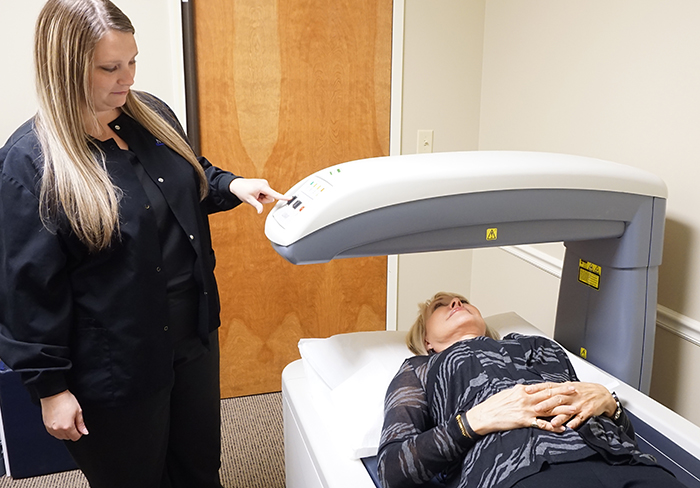Bone Density Scan (DEXA)

Bone density scanning, also called dual-energy X-ray absorptiometry (DXA or DEXA) or bone densitometry, is an enhanced form of X-ray technology that is used to measure bone loss. DEXA is today’s established standard for measuring bone mineral density (BMD). An X-ray (radiograph) is a painless medical test that helps your physician diagnose and treat medical conditions. Radiography involves exposing a part of the body to a small dose of ionizing radiation to produce pictures of the inside of the body. X-rays are the oldest and most frequently used form of medical imaging.
DEXA is most often performed on the lower spine and hips. Portable DEXA devices, including some that use ultrasound waves rather than X-rays, measure the wrist, fingers or heel and are sometimes used for screening purposes.
DEXA bone densitometry is most often used to diagnose osteoporosis, a condition that often affects women after menopause but may also be found in men. Osteoporosis involves a gradual loss of calcium, causing the bones to become thinner, more fragile and more likely to break. DEXA is also effective in tracking the effects of treatment for osteoporosis and other conditions that cause bone loss. The DEXA test can also assess an individual’s risk for developing fractures.
Causes of Osteoporosis
Suggested causes of osteoporosis include low calcium, low vitamin D, low phosphorus intake, high protein diets, high salt intake, trace mineral deficiencies, and even increased soft drink consumption. Proper testing will identify major and minor key elements of imbalance and deficiency, environmental toxicities, stress and physical structure, abnormal organ functions, digestive disorders, and much more. Through careful examination and analysis, we can help you determine your risk and determine what lifestyle changes you need to make in order for your body to heal itself, build bone mass and restore your health.
Candidates for Bone Density Testing
Bone density testing is strongly recommended if you:
- Post-menopausal woman not taking estrogen
- Personal or maternal history of hip fracture or smoking
- Post-menopausal woman who is tall (over 5 feet 7 inches) or thin (less than 125 pounds)
- Men with clinical conditions associated with bone loss
- Use medications that are known to cause bone loss, including corticosteroids such as prednisone, various anti-seizure medications such as dilantin and certain barbiturates, or high-dose thyroid replacement drugs
- have type 1 diabetes, liver disease, kidney disease or a family history of osteoporosis
- High bone turnover, which shows up in the form of excessive collagen in urine samples
- Have a thyroid condition, such as hyperthyroidism
- Have a parathyroid condition, such as hyperparathyroidism
- Experienced a fracture after only mild trauma
- X-ray evidence of vertebral fracture or other signs of osteoporosis
Few of us have ideal risk levels on all screening tests. However, if you do have test results that are less than ideal, it doesn’t mean you’re destined to develop a serious cardiovascular disease. On the contrary, it means you’re in position to begin changing your health in a positive way!
About the Procedure
The 30-minute procedure is very simple. Depending on whether your hip, spine, or wrist is being scanned, you will either lie on a table or sit in a chair. You may lie with your legs straight or with your lower legs resting on a platform to elevate them slightly.


